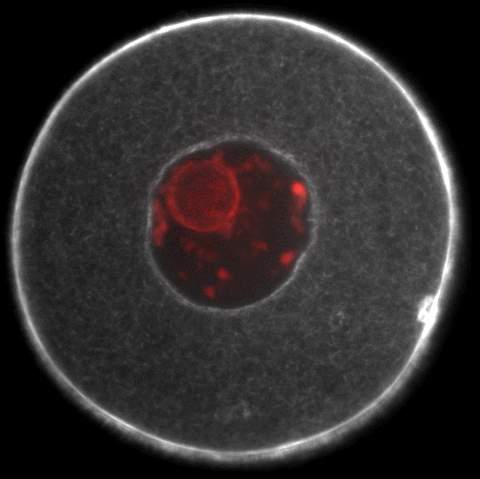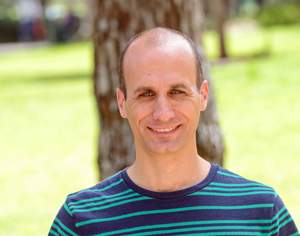Are you a journalist? Please sign up here for our press releases
Subscribe to our monthly newsletter:

Before an egg – whether mouse or human – can be fertilized, it must get its “internal affairs” in order. That includes moving its nucleus into position in the exact center of the cell. Under a microscope, the nucleus appears to do a little dance, jigging its way from the edge of the cell to the middle. What is really going on?
“This is a question that physics can answer,” says Prof. Nir Gov of the Weizmann Institute’s Chemical Physics Department. “We examine the physics of the biological molecules in the cell to see whether the means of motion that are proposed are mechanically possible.” Gov, a theoretical physicist, worked with physicists and biologists led by Prof. Marie-Helen Verlhac at the College de France in Paris, observing what happens to the nuclei in mouse egg cells.
The nucleus dance, they found, is the result of bumping: Tiny motorized sacs called vesicles continually collide with the nucleus. These vesicles run on tracks – the long, thin actin filaments that provide the cell with support – and they are transported by molecular motors made of a kind of myosin – a relative of the myosin that makes our muscles contract. (“The vesicles with their myosin motors underneath look like little people running on a track,” says Gov.)
But the actin fibers form a disorganized network in the cell’s cytoplasm, and the movement of the vesicles is random as well. How does this random motion turn into the directed movement of the nucleus? This is where the physics came in. The mechanism that indeed explains the movement turned out to be subtle but effective.
The researchers found that the motors carrying the vesicles move more vigorously at the cell’s outer edges and more slowly in its center. Since there is about the same number of vesicles everywhere, this means that the bumping is more intense from one side. As the nucleus moves in toward the center, however, the force of the vesicles striking it gradually drops until it reaches the point at which the pressure is equally low all around. The physical model for this motion also reveals that the myosin motors stir up the cytoplasm, making it more fluid so that the nucleus can slide through it more easily.

Further investigations showed that, unlike the active motion of the vesicles, “random thermal motion” – the heat-induced movement that makes molecules “jumpy” – cannot give rise to this type of movement, and would not be able to direct the nucleus to the center of the cell.
How does the differential velocity of the tiny motors arise in the cell? This open question is under further study. “This is the first time that we have seen such ‘active random motion’ perform work in biological systems,” says Gov. “Since almost all cells contain actin transport systems, we think it could play a role in other types of intracellular movements. As well as solving a biological puzzle, we have learned something new about basic physics by researching movement in cells,” he adds.
Prof. Nir Gov's research is supported by the Yeda-Sela Center for Basic Research. Prof. Gov is the incumbent of the Lee and William Abramowitz Professorial Chair of Biophysics.
For more on cellular mechanics see:Support for an Invasion